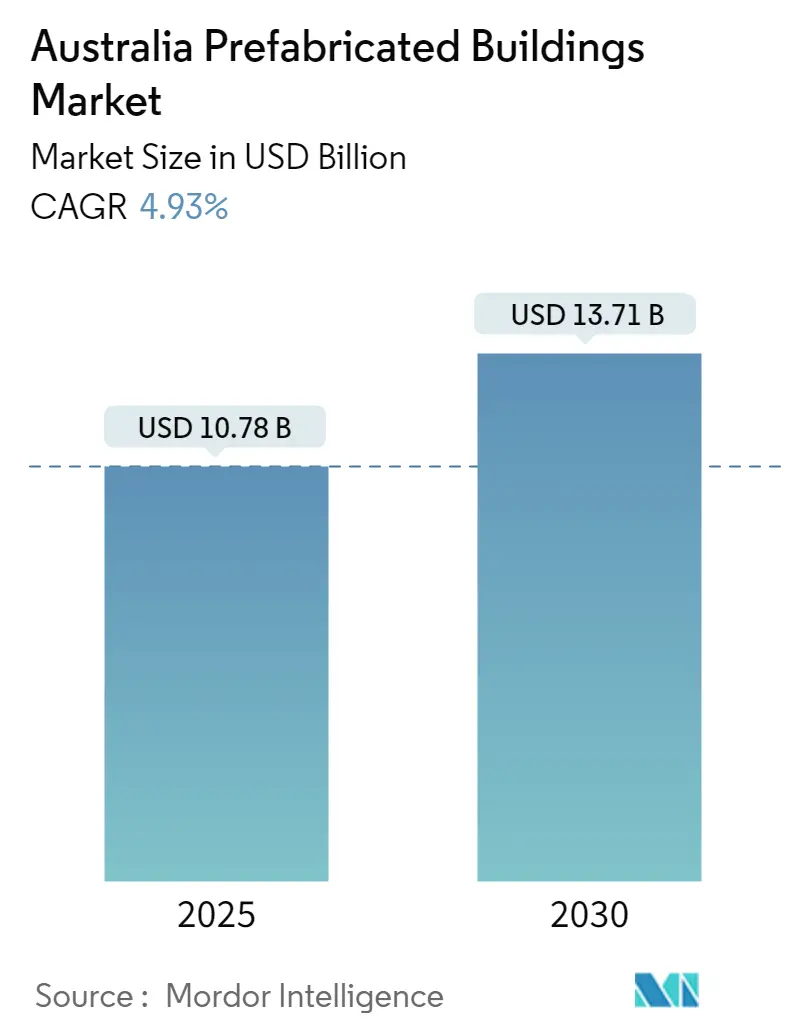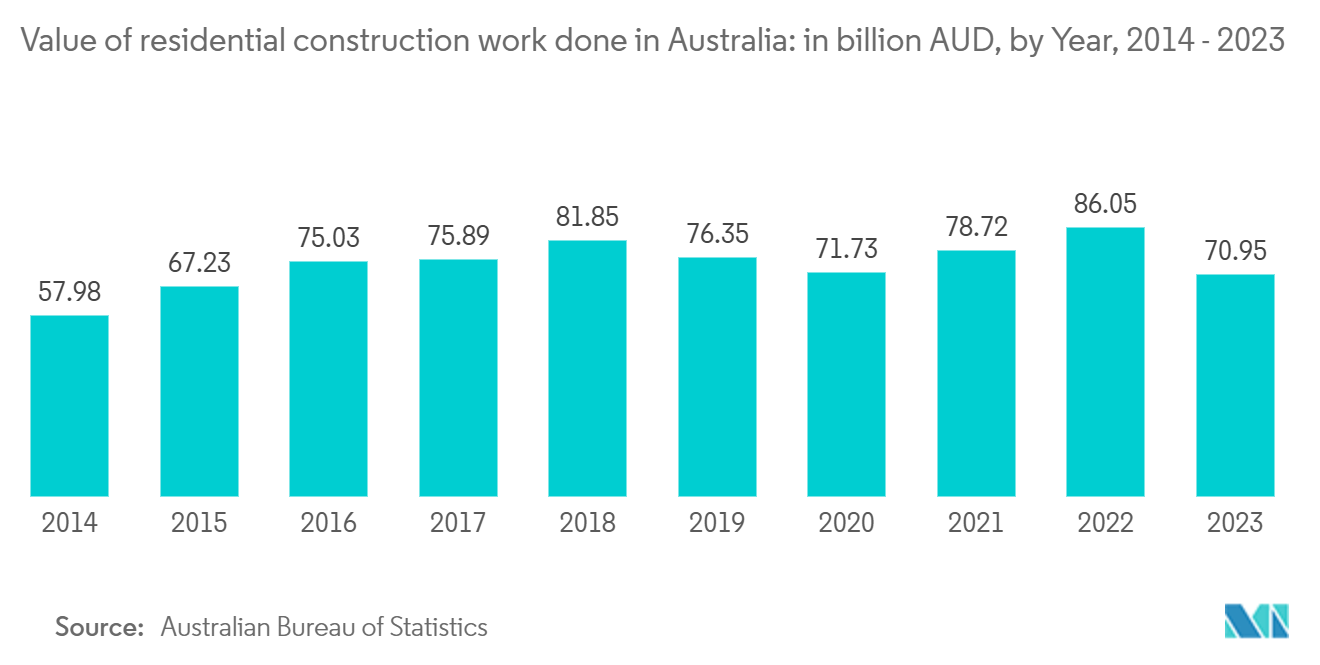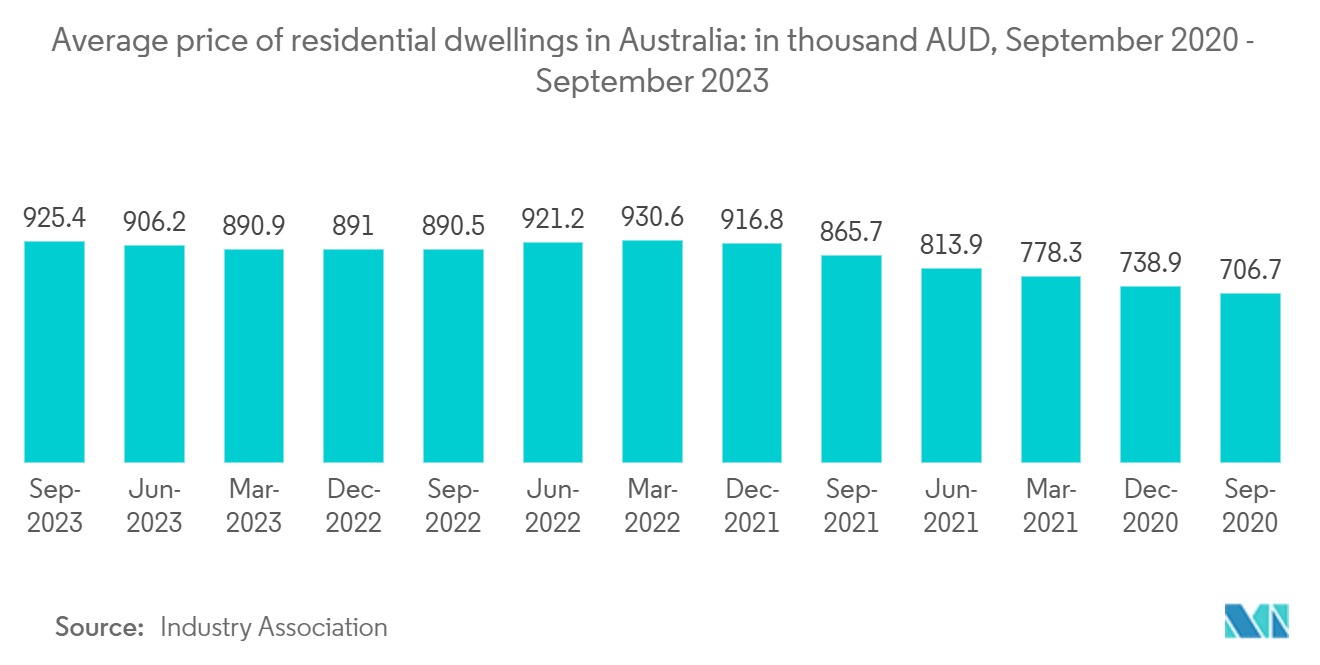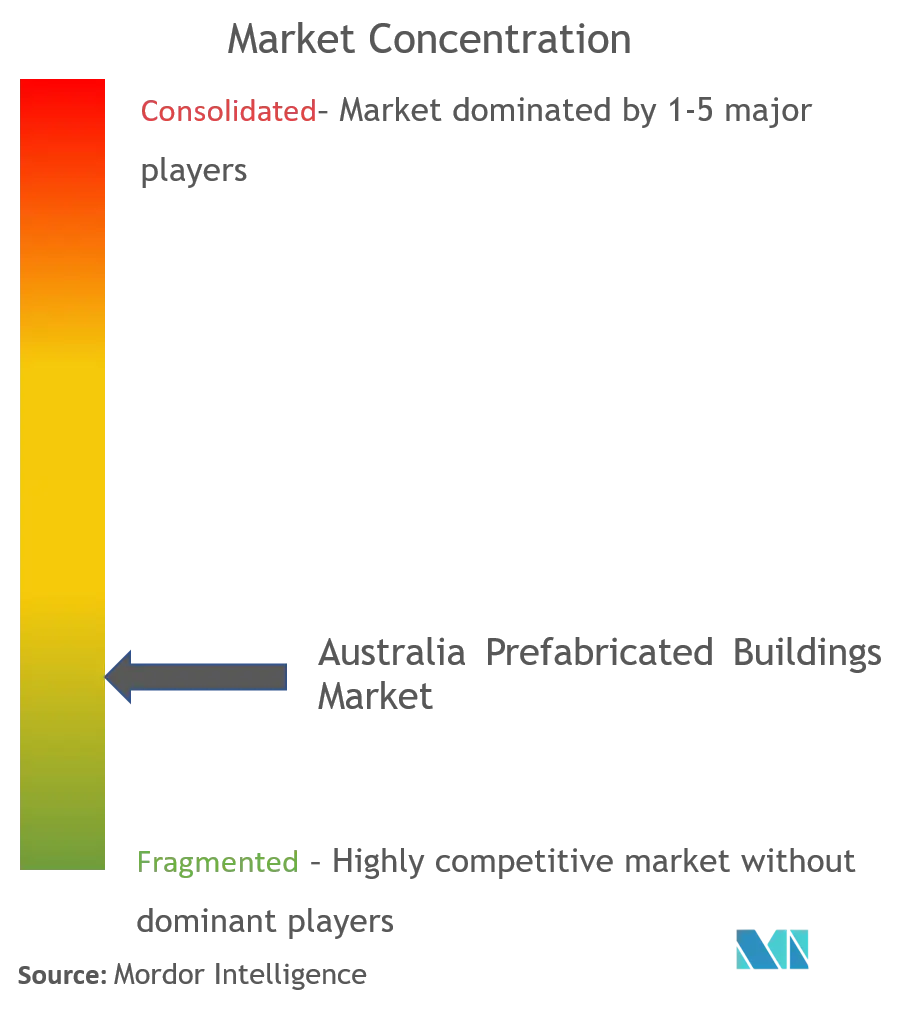Australia Prefabricated Buildings Market Analysis
The Australia Prefabricated Buildings Market size is estimated at USD 10.78 billion in 2025, and is expected to reach USD 13.71 billion by 2030, at a CAGR of 4.93% during the forecast period (2025-2030).
- The market is primarily driven by the demand for low to mid-rise residential buildings, project homes, and public housing. Increasing awareness about the benefits of prefabricated buildings, such as reduced material waste and less disruption to the surrounding environment, is driving market growth. Revenue in the market is expected to grow as the rising demand from the government and the education sector. The Australian modular construction market has faced severe challenges over the past two decades.
- The adoption of prefabricated solutions in Australia has increased significantly over the past few years. Industry associations and institutions in Australia are launching campaigns to create awareness about the benefits of the prefabricated industry. Leading companies in the market have recognized the productivity and efficiency gains that advanced manufacturing techniques can offer.
- Due to various causes, including a tight labor market, rising input costs, and increased demand due to government incentives, the construction and building industries have experienced significant price inflation in most states. The cost increases traditionally started in residential construction. However, these problems affect all types of construction.
- The construction industry has also seen significant delays in finishing projects due to labor shortages and a global supply deficit in several common building materials. The materials include steel, paint, cement, wood, cabinets, and electrical components. Compared to pre-pandemic levels, building material wait times have, at best, doubled and, at worst, increased by more than ten times. Construction projects have experienced completion delays and increased cost pressure due to the unfavorable weather affecting the East Coast since the start of the year.
- The adoption of prefabricated solutions in Australia has increased significantly over the past few years. Industry associations and institutions in Australia are launching campaigns to create awareness about the benefits of the prefabricated industry. Many public spaces in Australia, such as new railway stations, police stations, healthcare facilities, and community centers, are being built using volumetric modular construction and other prefabricated methods with the assistance of the Australian government. Hence, the market is expected to witness growth.
Australia Prefabricated Buildings Market Trends
Increasing Demand for New Building Construction in Australia is Driving the Market
- Australia is one of the nations with the highest economic growth, and its construction industry is flourishing. As public awareness of climate change and other environmental issues continues to rise, more and more people are seeking methods to live sustainably, leading to numerous new construction trends in Australia. One of Australia's most recent construction trends is the preference for modular construction techniques. Off-site construction methods like modular construction include building prefabricated modules in a factory setting before transporting them to the job site.
- The latest official data showed a significant decline in approvals in April. Rising costs of building materials and labor are pulling down new housing permits. According to the Australian Bureau of Statistics, after a decrease of 19.2% in March 2022, the number of residences permitted in Australia further decreased by 2.4% in April 2022. Approvals for detached homes increased by 0.5% to 10,077, while apartments and townhomes decreased by 6.1% to 4,701.
- As the industry returned to normal levels after the home builder-fueled boom in activity, total approvals witnessed a decline of 32.4%, with detached homes and apartments experiencing declines of 33.7% and 28.7%, respectively. By 2032, 163,400 dwellings were estimated to be less than what was previously predicted by the National Housing Finance Investment Corporation. The value of new residential construction increased by 4.4% to USD 6.054 billion, while renovations increased by 6.6% to slightly over USD 1 billion. Buildings other than homes saw a 30% decline, reaching a value of USD 4.35 billion.
Increasing costs of construction in Australia
- The average cost to build a home in Australia increased by over USD 94,000 in just 15 months. Mortgage holders across the country also felt the effects of the increase. Housing costs played a significant role in the inflation data that drove the Reserve Bank of Australia to raise interest rates by 1.5% over the past three months. According to an analysis of the building approvals data from the Australian Bureau of Statistics, the average cost of a new house permitted in the country's private sector in May 2022 was USD 413,436.
- In 2023, with an increase of 23.7% over the 12 months, residential property values experienced their highest yearly growth. Due to historically low borrowing rates and government assistance, Australia's real estate industry experienced exponential growth. Price increases were seen in all the major capital cities, with Hobart (+29.8%), Canberra (+28.8%), Brisbane (+27.8%), Sydney (+26.7%), and Adelaide (+23.9%) seeing the highest yearly increases. In the last 12 years, Melbourne (+20.0%) has seen the most considerable annual growth, followed by Perth (+15.7%) and Darwin (+13.0%). Due to the increase, Australia's real estate market was valued at USD 9.9 trillion, with the typical price of residential properties rising by another USD 44,000 to USD 920,100 nationwide.
- The government has been investigating housing affordability and supply due to high prices. The results are anticipated to be public this year. With many Australians being shut out of the real estate industry and others facing lifetime loans of millions of dollars, the price increase is causing a housing catastrophe.
Australia Prefabricated Buildings Industry Overview
The Australian modular construction market is fragmented and highly competitive due to the presence of global, regional, and local players. Some key players include Ausco Modular Construction Pty Ltd, Fleetwood Australia, Archiblox Pty. Ltd., Anchor Homes, and Prebuilt Commercial. Prefabricated building systems and construction hold a high potential to improve the efficiency and performance of the construction industry in a more sustainable way. With the market just opening up in the construction industry and generating trust and investments in technology, it is open to ample opportunities and is expected to witness substantial growth in the coming years.
Australia Prefabricated Buildings Market Leaders
-
Ausco Modular Construction Pty Ltd
-
Fleetwood Australia
-
Archiblox Pty. Ltd.
-
Anchor Homes
-
Prebuilt Commercial
- *Disclaimer: Major Players sorted in no particular order
Australia Prefabricated Buildings Market News
- November 2023: The Western Australian government announced the construction of over 200 modular homes as part of its commitment of AUD 2.4 billion to address homelessness in the state. Similarly, the Victorian government unveiled a plan the previous year, allocating AUD 30.38 million to build 114 energy-efficient prefabricated modular homes for individuals experiencing homelessness or facing the risk of it. The increasing adoption of modular housing is expected to lead to cost reductions in construction as manufacturing scales up and efficiencies are achieved.
- August 2023: Modscape participated in QBuild’s Modern Methods of Construction (MMC) Housing Program to address the immediate housing needs in Queensland. This initiative was aimed at providing affordable and sustainable housing to Queenslanders, from essential government workers to those struggling with homelessness. The Queensland government’s commitment to addressing the housing crisis in the state led to the prototyping of the QBuild MMC Housing Program. This program aims to build approximately 100 essential worker homes across regional Queensland using modern methods of construction (MMC). The program is expected to provide valuable insights into how MMC can be used to deliver affordable and sustainable housing.
Australia Prefabricated Buildings Industry Segmentation
Prefabrication, under modular construction, is the practice of assembling components of a structure in a factory or other manufacturing site and transporting complete assemblies or sub-assemblies to the construction site. A comprehensive background analysis of the market, including the assessment of the economy and contribution of sectors in the economy, market overview, market size estimation for key segments, emerging trends in the segments, market dynamics, geographical trends, and COVID-19 impact, is covered in the report.
The Australian modular construction market is segmented by material type (concrete, glass, metal, timber, and other material types) and application (residential, commercial, and other applications (infrastructure and industrial)). The report offers market sizes and forecasts in value terms (USD) for all the above segments.
| By Material Type | Concrete |
| Glass | |
| Metal | |
| Timber | |
| Other Material Types | |
| By Application | Residential |
| Commercial | |
| Other Applications (Infrastructure and Industrial) |
| Concrete |
| Glass |
| Metal |
| Timber |
| Other Material Types |
| Residential |
| Commercial |
| Other Applications (Infrastructure and Industrial) |
Australia Prefabricated Buildings Market Research Faqs
How big is the Australia Prefabricated Buildings Market?
The Australia Prefabricated Buildings Market size is expected to reach USD 10.78 billion in 2025 and grow at a CAGR of 4.93% to reach USD 13.71 billion by 2030.
What is the current Australia Prefabricated Buildings Market size?
In 2025, the Australia Prefabricated Buildings Market size is expected to reach USD 10.78 billion.
Who are the key players in Australia Prefabricated Buildings Market?
Ausco Modular Construction Pty Ltd, Fleetwood Australia, Archiblox Pty. Ltd., Anchor Homes and Prebuilt Commercial are the major companies operating in the Australia Prefabricated Buildings Market.
What years does this Australia Prefabricated Buildings Market cover, and what was the market size in 2024?
In 2024, the Australia Prefabricated Buildings Market size was estimated at USD 10.25 billion. The report covers the Australia Prefabricated Buildings Market historical market size for years: 2020, 2021, 2022, 2023 and 2024. The report also forecasts the Australia Prefabricated Buildings Market size for years: 2025, 2026, 2027, 2028, 2029 and 2030.
Our Best Selling Reports
Australia Prefabricated Buildings Industry Report
Statistics for the 2025 Australia Prefabricated Buildings market share, size and revenue growth rate, created by Mordor Intelligence™ Industry Reports. Australia Prefabricated Buildings analysis includes a market forecast outlook for 2025 to 2030 and historical overview. Get a sample of this industry analysis as a free report PDF download.







